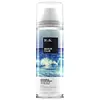What's inside
What's inside
 Key Ingredients
Key Ingredients

No key ingredients
 Benefits
Benefits

No benefits
 Concerns
Concerns

 Ingredients Side-by-side
Ingredients Side-by-side

Water
Skin ConditioningHydrofluorocarbon 152a
Dimethyl Ether
SolventPvp
Emulsion StabilisingVp/Va Copolymer
Phenoxyethanol
PreservativePEG-45 Palm Kernel Glycerides
EmulsifyingPPG-5-Ceteth-20
EmulsifyingCaprylyl Glycol
EmollientCarbomer
Emulsion StabilisingTriethanolamine
BufferingParfum
MaskingPolysorbate 20
EmulsifyingPolyquaternium-7
Tetrasodium EDTA
Benzophenone-4
UV AbsorberHydrofluorocarbon 152a
Alcohol Denat.
AntimicrobialDimethyl Ether
SolventVp/Va Copolymer
Pvp
Emulsion StabilisingZeolite
AbsorbentParfum
MaskingPhenethyl Benzoate
EmollientPolyisobutene
Water
Skin ConditioningGlycerin
HumectantPEG-12 Dimethicone
Skin ConditioningAmodimethicone
Ethylhexyl Methoxycinnamate
UV AbsorberButylene Glycol
HumectantHelianthus Annuus Seed Extract
Skin ConditioningHydrolyzed Wheat Protein
Skin ConditioningPhenoxyethanol
PreservativePotassium Sorbate
PreservativeBHT
AntioxidantBenzyl Salicylate
PerfumingCoumarin
PerfumingHydrofluorocarbon 152a, Alcohol Denat., Dimethyl Ether, Vp/Va Copolymer, Pvp, Zeolite, Parfum, Phenethyl Benzoate, Polyisobutene, Water, Glycerin, PEG-12 Dimethicone, Amodimethicone, Ethylhexyl Methoxycinnamate, Butylene Glycol, Helianthus Annuus Seed Extract, Hydrolyzed Wheat Protein, Phenoxyethanol, Potassium Sorbate, BHT, Benzyl Salicylate, Coumarin
Ingredients Explained
These ingredients are found in both products.
Ingredients higher up in an ingredient list are typically present in a larger amount.
This ingredient is also known by its brand name, Dymel-A.
It is a colorless gas and often used in aerosols.
We don't have a description for Hydrofluorocarbon 152a yet.
Parfum is a catch-all term for an ingredient or more that is used to give a scent to products.
Also called "fragrance", this ingredient can be a blend of hundreds of chemicals or plant oils. This means every product with "fragrance" or "parfum" in the ingredients list is a different mixture.
For instance, Habanolide is a proprietary trade name for a specific aroma chemical. When used as a fragrance ingredient in cosmetics, most aroma chemicals fall under the broad labeling category of “FRAGRANCE” or “PARFUM” according to EU and US regulations.
The term 'parfum' or 'fragrance' is not regulated in many countries. In many cases, it is up to the brand to define this term.
For instance, many brands choose to label themselves as "fragrance-free" because they are not using synthetic fragrances. However, their products may still contain ingredients such as essential oils that are considered a fragrance by INCI standards.
One example is Calendula flower extract. Calendula is an essential oil that still imparts a scent or 'fragrance'.
Depending on the blend, the ingredients in the mixture can cause allergies and sensitivities on the skin. Some ingredients that are known EU allergens include linalool and citronellol.
Parfum can also be used to mask or cover an unpleasant scent.
The bottom line is: not all fragrances/parfum/ingredients are created equally. If you are worried about fragrances, we recommend taking a closer look at an ingredient. And of course, we always recommend speaking with a professional.
Learn more about ParfumPhenoxyethanol is a preservative that has germicide, antimicrobial, and aromatic properties. Studies show that phenoxyethanol can prevent microbial growth. By itself, it has a scent that is similar to that of a rose.
It's often used in formulations along with Caprylyl Glycol to preserve the shelf life of products.
Pvp is a water-soluble synthetic polymer and common hairstyling ingredient. It is a film-forming ingredient and used to "hold" specific shapes of hair.
Pvp is less effective in high-humidity. It tends to draw moisture, but this moisture dismantles the structure and "hold".
We don't have a description for Vp/Va Copolymer yet.
Water. It's the most common cosmetic ingredient of all. You'll usually see it at the top of ingredient lists, meaning that it makes up the largest part of the product.
So why is it so popular? Water most often acts as a solvent - this means that it helps dissolve other ingredients into the formulation.
You'll also recognize water as that liquid we all need to stay alive. If you see this, drink a glass of water. Stay hydrated!
Learn more about Water